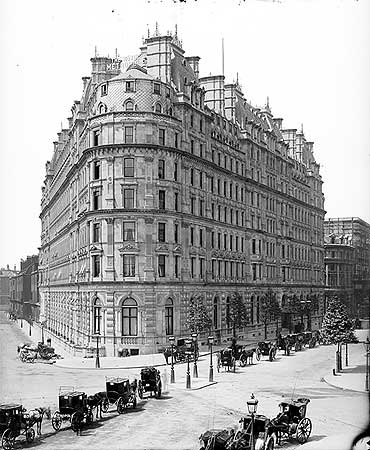In 1608–09, Henry Howard, 1st Earl of Northampton built a house on the eastern side of the former Chapel and Hospital of St. Mary Rounceval, at Charing Cross, including gardens running to the River Thames and adjoining Scotland Yard to the west. The estate became the property of Algernon Percy, 10th Earl of Northumberland when he married Howard’s great-great niece, Lady Elizabeth, in 1642, whereupon it was known as Northumberland House.
In June 1874, the whole of Northumberland House was purchased by the Metropolitan Board of Works and demolished to form Northumberland Avenue, which would accommodate hotels. The road was part built on the parallel Northumberland Street.
Contemporary planning permissions forbade hotels to be taller than the width of the road they were on; consequently Northumberland Avenue was built with a wide carriageway. Part of the parallel Northumberland Street was demolished in order to make way for the avenue’s eastern end. The hotels were popular for American visitors as they were near to the West End, government buildings on Whitehall and all the mainline stations.
The Grand Hotel was built between 1882 and 1887. It had seven floors, 500 rooms and a large ballroom which has largely survived intact from its original design. The original reception room was renamed the Mayflower Room in 1923, and is now called the Salon. Unlike other hotels on Northumberland Avenue that were taken over by the War Office, the Grand has survived as an entertainment and exhibition venue.
The Hotel Metropole was designed by Frederick Gordon and constructed between 1883 and 1885. Prince Albert, later King Edward VII, was a regular visitor to the hotel, entertaining guests in its Royal Suite. It had become one of the most popular hotels in London by the turn of the 20th century, being described by the War Office in 1914 as “of world-wide reputation”, and was the original location of the Aero Club and Alpine Club. In 1936, it was leased to the Government for £300,000 to provide temporary accommodation for various departments.
During World War II, room 424 was used as the headquarters of MI9, the principal section of military intelligence supporting Allied prisoners of war. The hotel continued to be operated as a government building after the war, and began to be used by the Air Ministry in 1951.
The Hotel Victoria opened in 1887, its name commemorating the Golden Jubilee of Queen Victoria held that year. It held 500 bedrooms and was the second largest hotel in London of its type on opening, overrunning its budget by around £520,000. The hotel was self-powered, generating its own electricity from dynamos. It was bought by Frederick Gordon in 1893, giving him a monopoly on all hotels on Northumberland Avenue. A refurbishment was started in 1911, though delayed due to the First World War, which resulted in a new annexe, the Edward VII Rooms. It closed in 1940 and was used by the War Office in need of extra accommodation. The War Office bought the building outright in 1951, renaming it the Victoria Buildings. It was subsequently renamed Northumberland House.
The Playhouse Theatre on Northumberland Avenue was built by Sefton Parry and opened in 1882 as the Avenue Theatre. George Alexander produced his first play here. In 1905, the theatre was destroyed after part of Charing Cross Station fell on it, and was rebuilt two years later. Alec Guinness first performed on stage at the theatre. It was used for BBC broadcasts from 1951 to 1975, broadcasting radio comedies such as The Goon Show and several sessions by the Beatles.
Thomas Edison’s British headquarters, Edison House, was situated on the road. Several prominent personalities of the late 19th century had their voices recorded there by phonograph, including Prime Minister William Ewart Gladstone and poet Robert Browning. Mary Helen Ferguson, the first English female audio typist, worked at Edison House and supervised all musical recordings. In 1890, retired military trumpeter Martin Lanfried recorded at Edison House using a bugle he believed to have been sounded at the Battle of Waterloo in 1815 and the Charge of the Light Brigade in 1854.
The Royal Commonwealth Society is at No. 18 Northumberland Avenue. It was founded in 1868 as the Colonial Society to improve relationships with colonies in the British Empire including Canada and Australia, and moved to its current premises in 1885. The current name dates from 1958, reflecting the change from the Empire to the Commonwealth of Nations. The Commonwealth Club opened on the premises in 1998 and features the only suspended glass dining room in London. The Royal African Society was based at the same location, before moving to the School of Oriental and African Studies in Russell Square.

